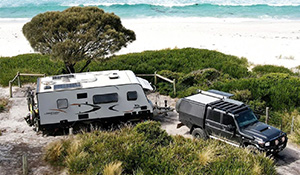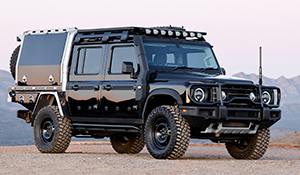How To: Use a diff lock
Words Dean Mellor
All modern 4x4s are equipped with electronic traction control, which, in some cases, is complemented by the fitment of a factory rear differential lock. Knowing when to use a locker and what effect it will have will allow you to drive further off the road than you might have thought possible.

Differential locks are nothing new and have, in fact, been around for much longer than electronic traction control systems. These days, many modern 4x4s are equipped with a factory rear diff lock in addition to traction control, and this mechanical traction aid can be very beneficial in certain off-road situations.
The differentials in your 4x4 allow opposing wheels across an axle to rotate at different speeds, which is important when your vehicle corners, as the outside wheels need to turn faster than the inside wheels because they have further to travel.
The most basic differentials are called open diffs, and while beneficial when cornering on the road, they can actually be a hindrance to forward progress when driving off-road, because they always distribute power to the wheel with the least resistance. So if, for example, you’re driving up an undulating track and your vehicle runs out of suspension travel to the point that one of your wheels loses contact with the ground, this is the wheel to which the open diff will send power. The result? The wheel in the air will spin uselessly while the wheel on the ground, the one with grip (resistance), will not receive any power, so forward progress will come to an abrupt stop.

Some vehicles are equipped with a limited-slip differential that’s designed to minimise this wheel spin in order to send some power to the wheel with grip. All modern vehicles also have electronic traction control that’s designed to apply brake pressure (resistance) to the spinning wheel, so the differential will send power to the wheel that has grip.
Some vehicles combine electronic traction control and a limited-slip rear diff to further minimise wheel spin in off-road situations, but even this combination is not a sure fire way to completely eliminate cross axle wheel spin.
The only way to completely ensure both wheels across the axle receive equal power, no matter if one wheel is on the ground and the other in the air, is if the differential is locked, which is why some 4x4s are equipped with a factory diff lock in addition to electronic traction control.

Do you have a rear diff lock?
While many modern 4x4 wagons and utes are fitted with a factory rear diff lock, others are not, and some are might have factory diff locks in both front and rear axles, including some Toyota LandCruiser 70 Series models and Mercedes-Benz G300 Professional models.
To ascertain whether your vehicle is fitted with a rear diff lock you simply need to have a hunt around the cabin for a switch that is either labelled ‘rear diff lock’ or has an illustration showing the rear diff with an ‘x’ through it. In most cases, when you engage the rear diff lock, an orange light will illuminate somewhere on the instrument binnacle, or in some cases you’ll be alerted via a graphic on the multi-information display.
It’s important to note that some full-time 4x4 vehicles will also have a switch to lock the centre diff, which ensures a 50:50 spread of power between front and rear axles, not across the rear axle. Don’t confuse this with a rear diff lock.
If you can’t locate a rear diff lock switch, have a look in your vehicle’s owner’s manual. With some vehicles, such as the Mitsubishi Triton, only the top-spec Exceed variant is equipped with a factory rear diff lock, while a rear diff lock is standard across the Ford Ranger 4x4 line-up.

How does a rear diff lock operate?
There are various locking differential designs on the market that operate in a variety of ways, but they all have some kind of mechanism inside the differential housing that locks up the diff, preventing differential action. While some diff locks operate automatically to prevent wheel spin (Land Rover Discovery, for example), many need to be actuated manually via a switch in the vehicle’s cabin.
Most factory diff locks are actuated electronically, as are some aftermarket diff locks (called E-Lockers), while other aftermarket diff locks are air activated (such as the ARB Air Locker and the TJM Prolocker).

When should you use your rear diff lock?
If your vehicle is equipped with a factory rear diff lock, when you use it will depend on several factors.
Firstly, your rear diff lock should never be used when driving on a hard surface, as the vehicle needs differential action in order to corner properly. If the rear diff is locked when you corner, the inside wheel will lose traction as it maintains the same speed as the outside wheel. This can adversely affect vehicle handling.
If the vehicle is equipped with an effective electronic traction control system (no, they’re not all equal), then you may never notice the need to engage the rear diff lock, but this doesn’t mean you shouldn’t. Electronic traction control relies on the vehicle’s braking system to provide resistance to the wheel without grip, so extended use could overheat the brakes.
Generally, you should engage the rear diff lock in any scenario where you think your vehicle might lose traction at one of the rear wheels, such as when driving on very undulating terrain, across large rocks or even through mud.


When confronted with challenging terrain, engage the diff lock before you need it. This will ensure both rear wheels will always receive drive no matter whether they’re both on the ground or not. There is, however, a caveat to this piece of advice: on some vehicles, the electronic traction control will default to ‘off’ when the factory rear diff lock is engaged, such as with Toyota HiLux. On some vehicles we have tested, hill-climbing capability has been better on extremely difficult tracks with the factory rear diff lock switched off, relying instead solely on the vehicle’s electronic traction control.
You should be able to figure out how the electronic traction control on your vehicle operates in conjunction with the rear diff lock after just a couple of tricky hillclimbs. If the vehicle struggles with the diff lock engaged, chances are the ETC has defaulted to ‘off’. If you’re not sure, ask the vehicle manufacturer how the system on your particular model operates.

Aftermarket diff locks
If your vehicle is not fitted with a factory rear diff lock, the 4WD aftermarket will likely have a solution for you.
While a rear diff lock can improve off-road performance, the addition of a front diff lock really completes the traction puzzle by guaranteeing all four wheels receive an equal amount of power regardless of whether they’re on the ground or not. And while the addition of a front diff lock is beneficial on any vehicle, it’s especially helpful on vehicles where engaging the factory rear diff lock disables the traction control.
Not only do front and rear diff locks allow you to drive further, they also allow you to conquer off-road obstacles with less gusto, which places less strain on driveline components and minimises the chance of breakages.
The four-wheel drive aftermarket can supply diff locks to suit the front and rear axles of most popular 4x4s, so if you’re not happy with your vehicle’s off-road capability, a set of lockers could be the answer.










